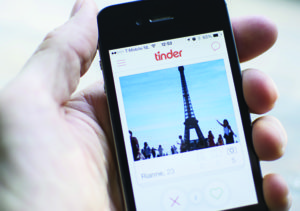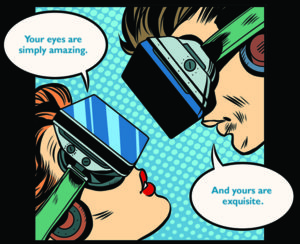The Future of Sex How technology, morality, and politics are reshaping human sexuality

STOP ME IF YOU’VE HEARD THIS: a Texas man is suing for the right to marry his Apple computer. Actually, stop me anyway. Chris Sevier’s real aim is to get the Supreme Court to overturn its decision legalizing gay marriage, but his federal lawsuit is so bizarre that not even Texas will back it. The state’s Republican Attorney General Ken Paxton asked a district court to dismiss it on the grounds that Obergefell v. Hodges does not extend to nonhumans.
And yet, even as Sevier was filing what Texas—the state that sued the Obama administration a whopping forty-six times—regards as a frivolous lawsuit, the world’s first robotic brothel opened its doors in Barcelona, Spain.
LumiDolls offers an in-house sexual experience that it promises will “allow you to fulfill your fantasies without any limits.” Presuming, of course, that you find sex dolls attractive. To be sure, these are no inflatable throwbacks. “All our dolls, like all women, have an oral, vaginal, and anal orifice,” the company says, adding that they are “completely realistic… both in the movement of their joints and to the touch.” Except that they are completely devoid of choice, personality, or will.
But that may soon change. Pau Ferriz, a partner in the LumiDolls venture, says that the company has planned from the outset to have its “sexual dolls” approach the kind of lifelike performances found on the HBO fictional series Westworld.
“In the future, LumiDolls will be able to interact more with the client,” Ferriz said in an email interview for this story. “They will be perfected, offering new functionalit[y] … that matches virtual reality with the relations with the dolls.”
Matt McMullen, founder of RealDolls, aims to get there first. His Southern California-based company is producing sex bots that possess not only “highly realistic” genitalia but also artificial intelligence (AI) generated personalities. The “Harmony” personality prototype already exists and can carry on a conversation—especially if the topic is sex. McMullen aims to incorporate AI into the sex doll, along with some animatronics, to produce a highly realistic sexual experience for his clients.
Realistic, but not too realistic. Researchers have found that when a robot is difficult to distinguish from a human it wanders into “uncanny valley.” That is to say, people experience revulsion at its failure to emote and behave just like a real person. McMullen knows this and has a counterstrategy.
“You can look at the best of my dolls, and you can still tell that’s a doll,” he says in a New York Times video interview. “If you keep away from super-realism, you’re in safer territory.”
Meantime, over at Dame, Inc., realism is the last thing on the list. Enterprising young women are designing ergonomically and visually appealing sex toys for women. In what may be a blow to male egos everywhere, their most popular products look nothing like a penis. “Women report wanting products that are aesthetic,” explains Dame CEO Alexandra Fine, who describes herself as a “pro-sex activist and capitalistic-feminist.”
Can this be the future of sex? The idea may sound as ridiculous as claiming a right to marry a laptop, yet technology has already asserted its presence in human sexuality to a remarkable extent. Bryony Cole, host of the Future of Sex podcast, predicts the pace of change in the next thirty years will likely exceed that of the past three hundred.
“What we are finding is that technology is helping [people] explore their sexuality in an entirely new way,” Cole says, “and that is creating new sorts of products.”
A Collapse of Traditional Morality?
Complex changes in human sexuality are already underway. They raise concerns about freedoms, boundaries, language, the role of the state, the power of religion, and the future of autonomy, intimacy, relationships, family, childrearing, and sexual minorities. Many have deep implications for humanism.
The single most important technological change in sex to date has been contraception. Some forms had been in use for centuries, but early in the twentieth century Margaret Sanger (1957 Humanist of the Year) ignited what would become a global revolution in birth control. With backing from Sanger and her investors, “the pill” propelled that revolution to escape velocity. It hit the market in 1960, and a few years later the Supreme Court’s discovery of a right of privacy in Griswold v. Connecticut assured that married women, at least, would have access. Eisenstadt v. Baird, brought before the high court by humanist Bill Baird in 1972, established the right of unmarried people to use contraception just as married couples.
Conservative religious leaders railed against the decisions, predicting a collapse of traditional morality. In a sense, they were right: the traditional confinement to the roles of wife and mother fell by the wayside as sexually active women stampeded into higher education and then knocked over barrier after barrier on their way to becoming a majority of college students and a majority in many graduate and professional schools, including law. “It all starts with educational attainment that leads to greater economic stability for women and their families,” Adam Sonfeld of the Guttmacher Institute said after releasing a 2014 report on the benefits of contraception.
Those benefits have had stunning social effects. Until the end of the nineteenth century, women in the United States, like women everywhere, were typically married off sometime between their tenth and eighteenth year. The average woman gave birth to seven children. Nearly a third had ten or more. Only maternal deaths kept the average from reaching double digits, while infant mortality claimed the lives of 28 percent of children. The life course of women now could not be more different. For many, marriage is off the table. As for motherhood, it’s a possibility often entertained after they hit their thirties.
In the past half-century, with contraception in widespread use and rising levels of women’s education, birth rates have plunged, along with child poverty and mortality. Teen pregnancy has dwindled from more than a quarter of all births to just 13 percent. By 2014 the average age of first pregnancy for American women reached 26.3 years—time enough for many to complete college and graduate school. The average has also been rising for minority women in the US—and the majority of women worldwide.
 The decoupling of sex and reproduction may have started in America, but it has raced around the world like a wind-whipped wildfire. Globally, according to World Bank data, since 1960 the number of births per woman has dropped by half to 2.5. In some countries, such as Italy, Japan, and Germany, it’s fallen well below the replacement rate to about 1.5 children per woman. Even in poor countries where conservative religion remains powerful, the trend stands out: In Afghanistan, fertility has fallen from 7.5 to 4.7 children, in Egypt from 6.6 to 3.3, and in Brazil fertility has fallen off a cliff, from 6.2 children to 1.8.
The decoupling of sex and reproduction may have started in America, but it has raced around the world like a wind-whipped wildfire. Globally, according to World Bank data, since 1960 the number of births per woman has dropped by half to 2.5. In some countries, such as Italy, Japan, and Germany, it’s fallen well below the replacement rate to about 1.5 children per woman. Even in poor countries where conservative religion remains powerful, the trend stands out: In Afghanistan, fertility has fallen from 7.5 to 4.7 children, in Egypt from 6.6 to 3.3, and in Brazil fertility has fallen off a cliff, from 6.2 children to 1.8.
These maternal changes have coincided in causally complex ways with the greatest social and economic changes since the dawn of agriculture more than 10,000 years ago. We have broken out of the Malthusian trap: since 1900 the human population has quadrupled and then some without mass starvation. (Famines that persist result from political and economic dysfunction, not lack of available food.) Over the same period, the human population has concentrated like never before: more than half of people have moved from the countryside to the city. By 2030 the UN Population Fund predicts some five billion people will inhabit cities. Given the mobility of people within cities and unprecedented levels of international travel, humankind has created a vast pool of potential partners.
Not Going to the Chapel, Not Gonna Get Married
For most of human history, parents selected mates for their children. For the past century or so, most people met future spouses in school, at dances, in the workplace, or at bars. This meant the pool of potential partners was small and, moreover, likely to be socioeconomically similar. But with the rise of Facebook, Twitter, and dating apps, whole new fields of opportunity opened. And with them, two, possibly three, new revolutions ignited. Marriage has withered, gay rights have proliferated, and hookup culture is thriving.
From 2000 to 2014 the proportion of young men who’ve never married shot up from around 18 percent to 23 percent, while the proportion of unmarried young women climbed from 12 to 17 percent. At the end of that time frame, for the first time the number of unmarried Americans exceeded those who are married.
“Almost 40 percent of America’s children are born to unmarried parents,” notes Stephanie Coontz, director of Research at the Council on Contemporary Families. In an essay for the journal Cato Unbound she adds that “people will continue to explore alternatives to marriage” for reasons that include “women’s economic independence, the abolition of legal penalties for illegitimacy, the expansion of consumer products that make single life easier for both men and women, and the steady decline in the state’s coercive power over personal life.”
A Rutgers University study found that young men feel at ease remaining single. Focus groups of men twenty-five to thirty-five years old in four major cities said being single works for them because sex is readily available, social pressures to marry have declined, they are in no hurry to become fathers, and the costs of marriage are steep.
Many young women feel the same way. Deciding not to marry means “you’re choosing happiness,” twenty-eight-year-old Holly Dembinski told the Washington Post in an article last year on why millennials were putting off marriage.
They may be single, but in that they are far from alone. UN data show marriage on the decline in 87 percent of the world’s nations. Numerous studies project a continuation of this trend.
If traditional marriage is in a slump, gay marriage is on the rise. In 1988, sociologist Robert Putnam writes in his 2010 book American Grace, only 12 percent of Americans favored gay marriage. By 2006 the number had tripled, and by the time the Supreme Court finally ruled in 2015 that gay marriage is a constitutional right, a majority of the public had already embraced that view. Since the dawn of the new millennium, two dozen countries have legalized gay marriage. This trend, however, is far from universal. It coincides largely with unrestricted Internet access, and that’s probably no coincidence.
Putnam believes social media has played a pivotal role. By connecting formerly isolated LGBT people and encouraging them to come out, it forced Americans to recognize that homosexuals are everywhere, and that, as Putnam says, their “Aunt Jane” or “Uncle Ernie” is gay, and they’re all right.
They may be more than all right. Gay marriage now comprises as much as 3 percent of all marriages in some cities. On average, same-sex couples earn more than hetero couples, though selection effects may distort the underlying reality. (In the early days of legalized gay marriage, it may be that the affluent same-sex couples get married first. It’s also a fact that gay marriage is concentrated in high-cost, high-wage metropolitan areas, while hetero marriage is widely distributed.)
So, add greater acceptance of alternative sexual orientations to mobility, and the pool of potential sex partners just got bigger. But how to find the right one?
Luckily, There’s an App for That
 Gay or straight, for those who don’t marry—and for some who do—the field of sexual choice is wide open. The use of dating apps—software for phones that allow a person to find and contact nearby potential partners in real time—has exploded. It began with Grindr, an app for gay and bisexual men that debuted in 2009, and was followed in 2012 by Tinder, an app for all comers, if you’ll pardon the expression. According to the Pew Research Center, as of early 2016 the number of eighteen- to twenty-four-year-olds who use such tools had nearly tripled in just two years, to 27 percent. Older people are also getting hip to online dating, Pew reports; the slice of fifty-five- to sixty-four-year-olds making use of online dating services doubled in the same period to 12 percent.
Gay or straight, for those who don’t marry—and for some who do—the field of sexual choice is wide open. The use of dating apps—software for phones that allow a person to find and contact nearby potential partners in real time—has exploded. It began with Grindr, an app for gay and bisexual men that debuted in 2009, and was followed in 2012 by Tinder, an app for all comers, if you’ll pardon the expression. According to the Pew Research Center, as of early 2016 the number of eighteen- to twenty-four-year-olds who use such tools had nearly tripled in just two years, to 27 percent. Older people are also getting hip to online dating, Pew reports; the slice of fifty-five- to sixty-four-year-olds making use of online dating services doubled in the same period to 12 percent.
Ironically, this takes place at the same time that many are bewailing the “demise of dating.” What they mean, generally speaking, is the alleged end of a genteel practice of going out on several dates to get to know one another before diving under the sheets. In what has come to be called “the Tinder Effect,” some young people compete to see how rapidly they can bed the greatest number of desirable partners.
Writing in Vanity Fair a few years ago (“Tinder and the Dawn of the ‘Dating Apocalypse’”), Nancy Jo Sales quoted a young investment banker she called “Alex” on the advantages of Tinder over old-style bar-hopping: “You could talk to two or three girls at a bar and pick the best one, or you can swipe a couple hundred people a day—the sample size is so much larger,” Alex explained. “It’s setting up two or three Tinder dates a week and, chances are, sleeping with all of them, so you could rack up 100 girls you’ve slept with in a year.”
Now, before you chalk this up to an assumption that all investment bankers are porcine, remember that similar stories raised eyebrows in the early 1980s, and yet relationships survived the Disco plague. Still, there is valid concern about an erosion of intimacy. Displacing the date is the “hookup,” which New York Times columnist Charles M. Blow defined as “a casual sexual encounter with no expectation of future emotional commitment.”
Writing in 2008, Blow predicted, “Hooking up is here to stay.” Seems he was right. In a 2012 journal article, researcher Justin Garcia of the Kinsey Institute observed that the “vast majority of today’s young adults … report some personal ‘casual’ sexual experience.” This is not of concern to religious moralists alone; intimacy, with all its tendrils of emotional openness, risk, and engagement, lies alongside reason and mutual respect at the core of humanism.
The Bill Chill?
All this change has not passed unnoticed. Attempts to use the coercive power of the state to regulate, restrict, or punish sex and its outcomes have proliferated. From the conservative end of the spectrum, attacks on the right to exercise reproductive freedom have spread in extent and aim. Abortion remains the bullseye, but there are plenty of darts aimed at contraceptives, sex education, and women’s sexual and reproductive health.
Meanwhile, a nascent transgender rights movement has been met with fear, hostility, and a rash of laws requiring anyone using public restrooms to enter the one designated for the gender listed on their birth certificate.
At the same time, schools and college campuses have become battlegrounds over sex, speech, rape, and due process. Responding to shocking accounts of campus rapes treated as boys-will-be-boys high jinks, the Obama administration’s Department of Education in 2011 issued a nineteen-page “Dear Colleague” letter detailing how institutions receiving federal funds are to respond to sexual misconduct allegations. The instructions deliberately blurred the distinctions between harassment (“unwelcome attentions of a sexual nature”) and sexual violence, up to and including rape, as well as the distinction between dispute resolution and criminal investigation. It stated, for example, that the “preponderance of the evidence is the appropriate standard for investigating allegations of sexual harassment or violence.”
Two years later, Congress tightened the screws with passage of the Campus Sexual Violence Elimination Act. While there is near-universal agreement that more needs to be done to deter sexual assault and punish perpetrators, civil libertarians are concerned that a “sex bureaucracy” has emerged, with manifestly unattainable standards, such as continuous affirmative consent during sex and unjust standards for a finding of guilt on the heinous allegation of rape.
In a 2016 California Law Review article, Harvard law professors Jacob Gersen and Jeannie Suk wrote, “Our claim is not just that the set of sexual conduct classified as illegal has grown or changed—though it has—but that non-violent, voluntary sex—whether considered ordinary, idiosyncratic, normal, or perverse—is today regulated by the bureaucracy.”
All of which invites the question: If human sex becomes too dangerous or too prohibitive, will more people take the virtual/robotic route? And is that necessarily a bad thing?
Remote Control Sex

Bryony Cole, host of Future of Sex podcast. (Photo by Kelsey Cherry)
Given the crusading right-wingers, PC enforcers, and the incessant ding of social alerts, it would be easy to slip into a funk about the future of sex. But does all this folderol mean that intimacy and commitment are dead? Bryony Cole (the Future of Sex podcast host) encounters this all the time—and counters it with a touch of healthy skepticism. Work schedules and travel keep many couples apart, she says, but technology plays an important role in maintaining their intimacy at a distance. “The obvious are Facetime and Skype, but the more advanced are able to use technology like teledildonics” to experience sexual intimacy from afar. Teledildonics has to do with communicating tactile sensations remotely (you scratch my backside, I’ll scratch yours).
That’s just the beginning. Picture, Cole suggests, “one person from Brisbane and the other in London. Haptic suits will enable you to truly feel their touch, the slight graze of a knee, a touch on shoulder or gentle nudge. Virtual reality (VR) will soon enable people to conduct entire relationships, from the first kiss to the final goodbye, in a virtual world.” By 2028, she adds, “over a quarter of young people will have had a long-distance sexual experience.”
Cole contends that technological sex can likewise help disabled, disfigured, or otherwise sidelined individuals to begin to restore their sex lives.
At the same time, virtual reality is helping to overcome the shortfalls or absence of sex education in much of the United States and elsewhere—and porn production companies are leading the way. Earlier this year, for example, industry leader Pornhub opened a sex-education site online. Some may find its pedagogy dubious—the content includes a ten-minute video titled, “Young Boy Receives Real Thorough Sex Education From Two Hot Moms.” Say what you will, the video has nearly 2.7 million views.
 Cole sees this as just a first step in a new era of sex education. “Showing the realities of sex more immersively through something like VR could help correct the distorted view teenagers develop when online porn is their only educational source.”
Cole sees this as just a first step in a new era of sex education. “Showing the realities of sex more immersively through something like VR could help correct the distorted view teenagers develop when online porn is their only educational source.”
BaDoinkVR, which provides immersive porn videos for adults, has launched Virtual Sexology, intended to be used with VR goggles to provide an immersive, educational sex experience, guided by licensed sex therapist Hernando Chavez.
“I think there is great potential for VR sex education,” Cole says, “and hopefully we will see more nuanced, diverse, inclusive content in the not-too-distant future from a variety of sources, not just porn companies.”
As Nature Intended
Coming from a tech background herself (she’s worked for Microsoft and others), Cole launched her Future of Sex podcast in October 2016 and was met with so much enthusiasm that she opened it up to live audiences in Brooklyn, her adopted home, and in her native Australia. But along with the enthusiasm, she notes, “there’s a lot of anxiety about sex out there.”
Little wonder. Sex is one of nature’s strangest inventions. Inherently unfair, costly, and complicated, sex drives people crazy. Especially biologists. “The origin and evolution of sexual reproduction remains a mystery,” researchers Rama Singh and Carlo Artieri wrote in a 2010 paper published in the journal Heredity. “Why should a population tolerate a large proportion of males (typically 50 percent), individuals who often contribute nothing more than gametes to the act of reproduction?”
Good question. In the beginning, there was only replication. Cells divided, and that was that. Even among multicellular organisms, the path to self-reproduction beckons. Many female animals, including sharks, engage in so-called parthenogenesis. No males need apply. By rights, such cloning should be all the genetic rage.
As it is, sex imposes what the great biologist John Maynard Smith called a two-fold cost. First, a male has to consume at least as many resources as a female just to get to the stage of being able to fertilize her egg. Then she has to raise males as well as females in the next generation. A male-shunning self-reproducer ought to outcompete the sexy lady every time. But she doesn’t. And therein lies the mystery.
An answer has emerged, with evidence to back it. Sex, it seems, is nature’s equivalent of changing your password. Sex leads to offspring with novel genomes, and that keeps large organisms one step ahead of the parasites and pathogens that are always in hot pursuit. A just-published study of snails bolsters this view—while double-underlining the inequity of sex.
Researchers in New Zealand observed a species of snails that has both sexual and asexual females in the wild in roughly equal proportion. But when they gathered equal numbers and put them in sheltered tanks, the asexual females rapidly outproduced the sexual ones. “Our findings mean that Maynard Smith’s theory does apply,” said Dr. Amanda Gibson, lead author of the study, “and sexual females do pay at least a two-fold cost of sex.”
The human cost is extraordinary: of all mammals, women have the most difficult reproductive system, and their babies are the most needy. Why bother with it all? Could it be that the Tinder Effect is just what nature intended?
Love Wins
To find sex at its least intimate, the Pacific Northwest is where you should look. Here salmon return to have the one and only mating experience of their lives. For us, it’s a clear demonstration of how uncaring evolution can be; for the salmon, it’s a one-way trip to the morgue. As they make the upstream journey to their birthplace, their stomachs shut down and they literally begin to starve. Exhausted though they may be on arrival, the females must dig a trench for egg laying, while the males compete for the right to fertilize. After all that, the winning male gets to dump a sperm packet over the eggs and die—as does the mother. That’s it. (And you thought your sex life was bad?)
What makes human sex different—and what guarantees that intimacy will survive even with the intrusion of the bishop, the Church Lady, Big Brother, Tinder, and Instagram—is love, sweet love.
Yes, figuratively speaking, evolution does have a plan for your sex life. Like many of evolution’s adaptive behavioral schemes, it is a roughshod, flawed, just-good-enough sort of plan. And here it is: You’ll fall in love, become a parent, switch some of that love to your offspring, and then, swimming against a rising tide of resentment, bickering, straying, and suffering, tolerate each other at least long enough to raise your child who will do it all over again.
If that sounds cynical, consider these lines from a recent Slate article titled, “You Will Hate Your Husband after Your Kid Is Born”:
Perhaps the single most widely cited piece of research on marriage and children comes from couples’ therapists John and Julie Gottman, who found that 67 percent of couples are less satisfied with their marriages after having a baby. A 2009 study of first-time parents in the Journal of Personality and Social Psychology found that a scant 7 percent of mothers reported feeling more satisfied with their marriage, compared with 15 percent of fathers.
This stems from what evolutionary psychologist and 2006 Humanist of the Year Steven Pinker calls the tragedy of the human condition. “The seeds of unhappiness in every family have the same underlying source,” he writes in his book The Blank Slate. “Though relatives have common interests because of their common genes, the degree of overlap is not identical.” In short, we’re programmed to bond together in families and then squabble over our conflicting genetic interests.
Still, while we cannot repeal human nature, we can work to understand and compensate for its shortcomings.
Absent radical interventions in the human genome, it’s a safe bet that however much people experiment in hookups, virtual sex, or fun with robots, they will continue to yearn for stable, intimate, loving relationships. Humanism has a critical role to play in developing better, more just ways to deal with the conflicts that human nature entails.
Simplistic, evolution-free answers won’t serve; our violent history has left many conflicting impulses in our sexual psyches. (Consider: if plain-vanilla sex appealed to everyone, Fifty Shades of Gray would never have become a bestseller.)
Adopting one advocacy group or another’s stance also won’t serve. Stepping behind philosopher John Rawls’ “veil of ignorance,” to take an impartial stance might help us to come up with more just ways to deal with allegations of sexual mistreatment or assault.
Change will continue, but clear thinking can outpace it. As Bryony Cole says, “Intimacy is at stake. But it’s not the technology that’s to blame. It’s all in the choices we make about how to use it.”
It’s worth remembering that humans have a masturbatory gift for self-gratification, yet few are content with that alone. Writing in Psychology Today, Dr. Noam Shpancer observes, “sex is truly pleasurable because through it we may transcend our aloneness and form a meaningful bond with another human being.”
Indeed. As cultural evolution recontours our behavior and norms, love, imperfect though it may be, will remain our greatest ally in the quest for healthy, satisfying sexual relations.
